Although not as basic as the flat press, the incline bench press is an important muscle builder. This exercise is very complete and will help you gain strength and muscles in the chest, shoulders and arms . Read our complete guide to the incline bench press and get the most out of this exercise.
Why use the incline bench press?
Building a great torso means developing your pecs as fully as possible . To achieve this, you need to use angles . Both the incline and decline of the bench help create powerful pecs by influencing different parts of your muscles.
The pectoral muscles are made up of the pectoralis major and pectoralis minor. The "major" is the largest muscle, and the minor is a smaller triangle below it.
Both cannot be trained efficiently with a standard flat bench. By adding incline (or decline) pressing you can hit different muscle fibers, which will help you train your pecs. Keep in mind that the more you incline the bench, the more stress will be placed on your shoulders, so be careful and find the angle of the incline bench press where you take the stress off your shoulders.
Incline bench press (or upper chest bench press) and the muscles involved
The incline bench press , also commonly known in gyms as the "upper chest bench press" , is a compound exercise that engages multiple muscles during its performance. These muscles are the following:
Pectoralis major (mainly).
Anterior deltoids (or front part of the shoulder).
Long head of the triceps .
Secondarily, the serratus, the dorsal or the biceps are involved.
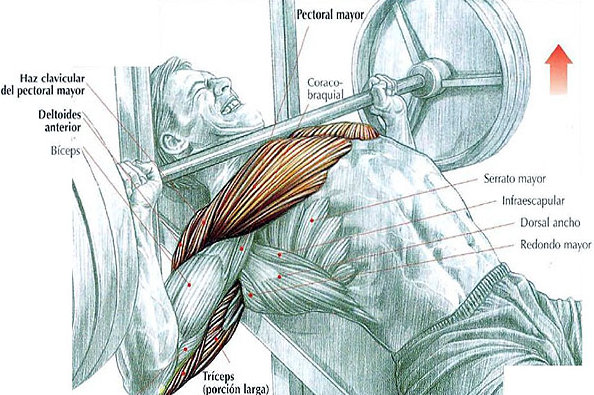
An incline bench press is something you should include in your routine. Working from this angle can improve your upper pecs in a way that other exercises can't match. The movement of raising the arms above the head shortens the clavicular part of the pectorals, which means that a greater incline puts more pressure on the head of the pectorals and the deltoids .
Although you will usually have to reduce the weight compared to the flat bench, the incline bench is a must if you are serious about bench strength exercises. The incline bench press or upper chest bench press is performed on a bench with an incline. As you will see now, and contrary to what many people think, the inclination of the bench does not have to be very exaggerated if what we are looking for is to work more on the upper chest area.
There are two main ways to do this exercise: barbell incline bench press and dumbbell incline bench press . In both cases, an incline bench is essential , which can also be of various types:
- A bench with fixed incline and built-in support is usually the one that we find in all commercial gyms to perform the upper chest bench press with the bar .
- An adjustable bench allows you to do incline bench presses at different degrees of incline. It is mainly used to do the exercise with dumbbells. These benches can be found in commercial gyms, although there are also home adjustable benches for upper chest pressing at home .
- The adjustable bench can also be used with a pair of supports to place a bar.
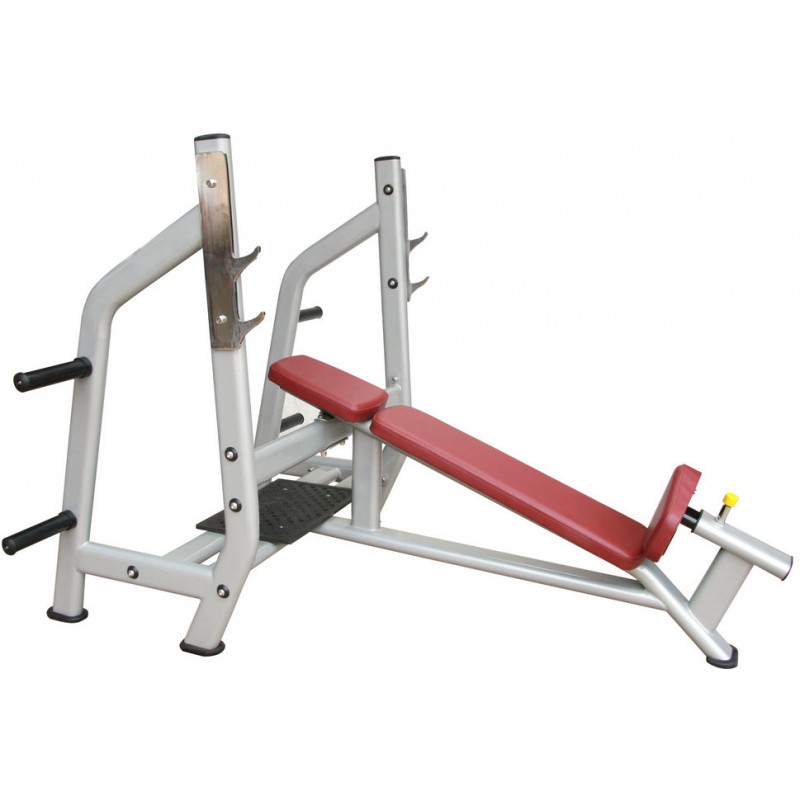 |
| Example of a gym incline bench press. The tilt is fixed. |
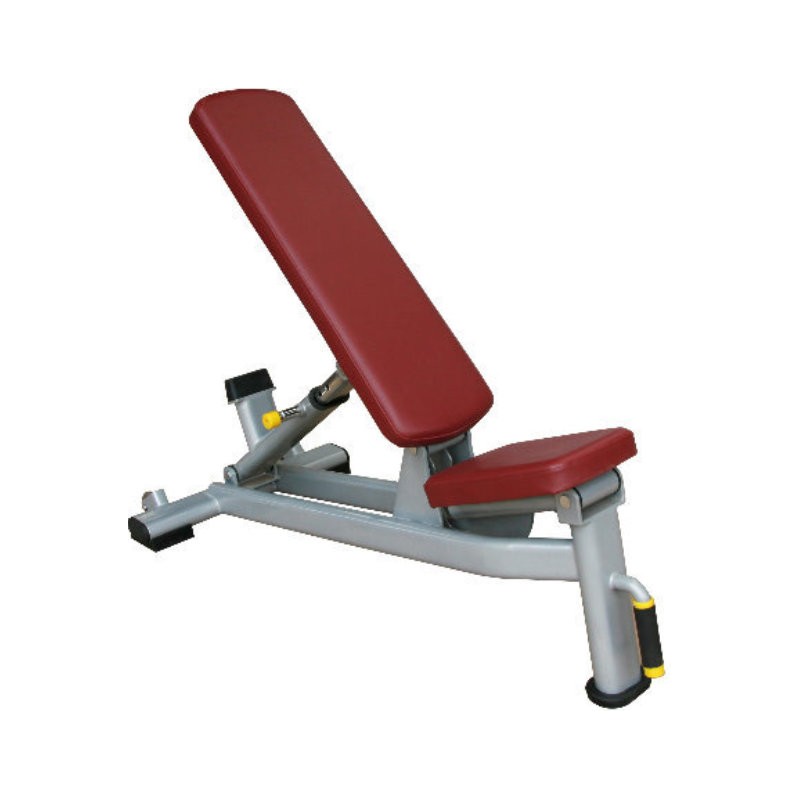 |
| This other bench is adjustable. It allows to vary the inclination of the backrest in several degrees and is usually used to work the chest with a pair of dumbbells. |
Now let's talk about the correct incline angle of the bench to perform this exercise.
The incline bench press and its degrees. What is the proper tilt angle?
To perform a barbell incline bench press , you'll need the bench we've mentioned and the racks. Ideally, the bench should be positioned at an angle of about 15-30 degrees . If you do the exercise at a higher incline, you can risk locating the work on the wrong muscles and your shoulders taking up most of the effort (something you don't want if you're looking to isolate your pecs). There are also some people who claim that they feel better exercising with a 45 degree incline.
Video showing the recommended incline from 15 to 30 degrees; by the bench press champion of Spain, Jesús Varela (Bilbo):
You'll have to experiment with the incline bench press to different degrees to see how you feel. You'll usually only need to lift the bench 2 or 3 slots, depending on how far apart they are.
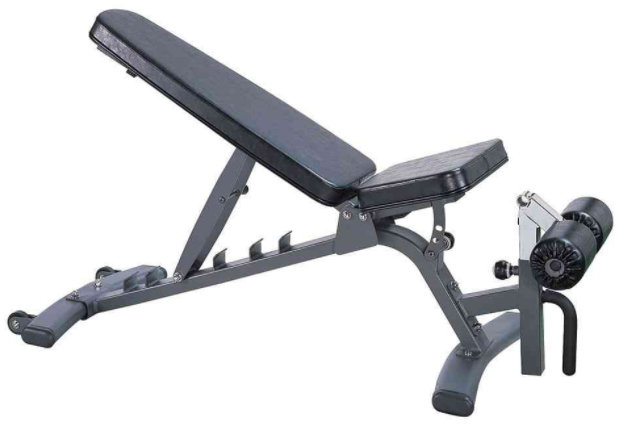
It's important not to angle it too far up , as increasing the angle too much will target your shoulders and basically almost do a shoulder press.
Remember, the angle of the incline bench press will depend on what feels right for you. Take the bar out and practice to see if you feel the tension in your upper chest or shoulders.
Learn how to use bench inclines in your training
You can use the dumbbells to extend the range of motion and really target your chest. Even employing various incline angles as you work your upper chest bench press sets can make you feel much more pumped.
EXAMPLE OF A ROUTINE FOCUSED ON THE UPPER CHEST BENCH PRESS THAT YOU CAN ADD TO YOUR CHEST DAY
- 3 x 8-12 reps incline barbell bench press (adjust the incline of the bench on each set between comfortable ranges, ie 15 degrees on the first set, 30 degrees on the second and 45 degrees on the third set).
- 3 x 10 repetitions of dumbbell incline press .
How to Do the Barbell Upper Chest Bench Press Using Correct Technique
If you want to build a perfect chest with a prominent upper body, then do the incline barbell press as well as dumbbell presses . Putting emphasis on the upper part will make your chest appear larger. It will grow so big that you could even hold a glass of water on it!
The bench tilt should be around 15-30º, but more on that later.
1. Lie down on the bench. Keep the soles of your feet flat on the ground, your buttocks in contact with the lower support and your back resting on the long support of the bench.
2. Grab the bar with a slightly wider than shoulder-width grip. Bring your shoulder blades together and keep your shoulders back to push your chest out (scapular retraction). Once you're compact, get a firm grip on the bar (with your thumbs around it if possible) and pull it safely out of the rack.
3. Once the bar is out, fill your lungs with air and hold. Push your feet against the ground and lower the bar in a controlled manner until it touches your upper chest.
4. Touching your chest, explosively raise the bar back to the starting position, until your arms are fully extended. Release the air from your lungs at the end of the movement. Remember to keep your shoulder blades together and your shoulders back throughout the incline barbell press. You will have completed one repetition.
It's also important that you keep your abs tight and tense throughout the exercise; that will give you more strength. If you want to make it more difficult, take a small stop for 1 or 2 seconds when the bar reaches your chest.
When you complete the reps you want, carefully set the bar back down on the rack. If you are going to use heavy weights, it is better to have a partner watch you.
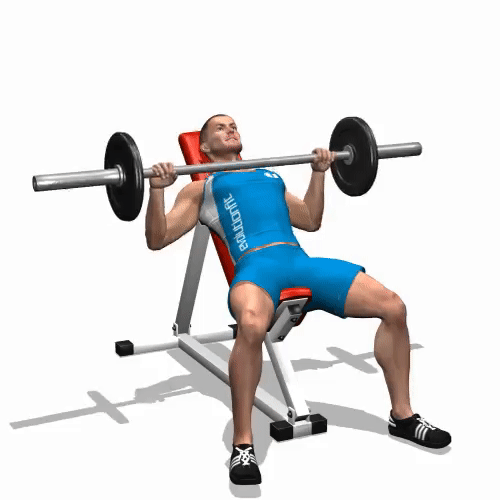
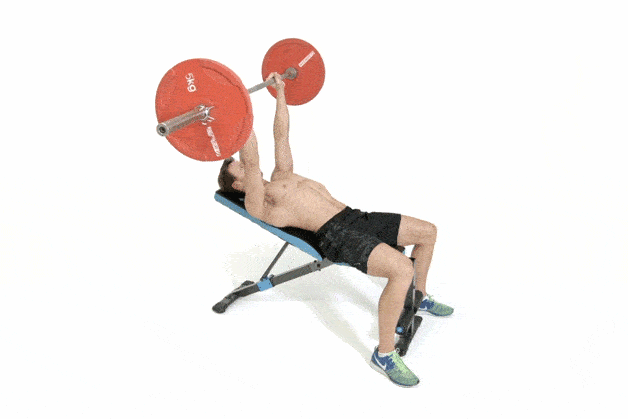
The secret to getting the most out of the incline bench press lies in the bench.
This exercise develops the upper chest . Although it also affects the middle section of the pectoral and requires the strength of the triceps to work. To a lesser extent, it also exercises the front deltoids . Working this exercise gives the pectoral a very nice shape, since it emphasizes the size especially in the upper fibers.
Experienced bodybuilders have mixed opinions about the need to include the incline bench press in routines. Some believe that this exercise must necessarily be included in the routine to develop the pectoral muscles. While others think that exercise should be included only temporarily and to add variety to training. Everyone should make their choice; but in any case it is very important to know all the characteristics and benefits of this exercise.
You will distinguish this exercise from the flat or decline bench press by the bench top incline . The angle of inclination should not be so accentuated; normally it will be about 30 degrees . A stationary gym bench with barbell mounts will usually bring that approximate incline. If the bench is adjustable, you will have the opportunity to adjust the angle to your optimum position. In any case, you must always keep your feet in contact with the ground. Keeping them in the air while carrying weight makes you lose stability and can cause a back injury.
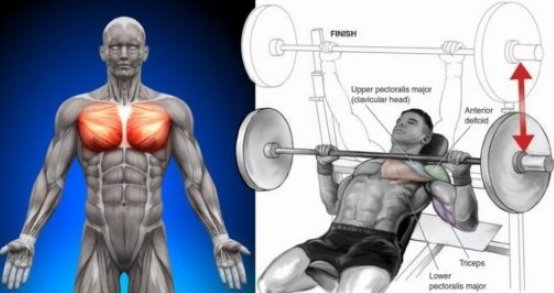 |
| Learning the incline bench press technique well will allow us to give more work to the pectoral and achieve the size we are looking for. |
There are a few recommendations that apply to both the incline bench press and the other bench presses.
- When performing this exercise, it is important that the hands move in a vertical plane . Although you can move your hands slightly closer to your face as you raise the bar ( be careful that the bar does not hit the supports ). Most athletes are used to bench pressing flat and can control the position of their hands so they don't drift forward.
- Prevent the wrists from bending backwards, because in this situation it is more difficult to maintain control over the bar.
- When going up, remember not to push the bar towards the abdomen or legs, but rather towards the face or vertically. You would lose control of the exercise.
- It is also very important to do several sets of approach or warm -up with the empty bar or with light weight discs to feel the mechanics of movement and prepare muscles and joints for loads. This is especially important if the upper chest bench press is going to be the first exercise in your routine.
- The ideal is to lower the bar until it touches the upper part of the chest. If you want the maximum stretch of the fibers this is the most correct. However, some professional bodybuilders lower the bar to "almost touch the chest" or leave it a few inches from the chest. Over time, each athlete develops his own technique with which he feels the most muscle to work. We will always recommend touching your chest , especially to beginners .
- Lowering the bar to the abdomen or neck makes it difficult to climb and is also very dangerous. In those cases, if the bar slips out of your hands, it can fall on your neck or stomach, which is fatal.
Before working out with heavy weights on the incline bench press , do several approaches with weights to warm up . Do not increase the working weight until you are sure you have mastered the incline barbell press technique . Be sure to ask a spotter for help , even if you're sure you can get the reps on your own.
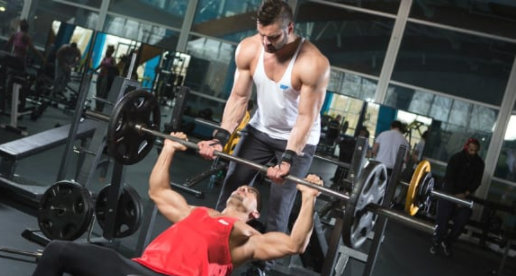 |
| The upper bar press is an exercise in which it is really important to have a spotter to help us with the bar in case the repetition fails. |
Incline Bench Press Benefits
This is a compound exercise that you can include in various sports such as bodybuilding or crossfit; and also as a complement to sports such as martial arts, boxing or football. Let's take a look at several benefits that the incline bench press brings .
- The greatest benefit is the great workload it provides to the pectoralis major . It gives more volume to the chest.
- Provides strength and explosiveness in the chest and arms; very beneficial for martial arts and contact sports. It is even efficient to gain running speed thanks to the increase in muscle mass in the torso.
- Improves strength and muscle mass in the triceps and deltoids (front area) .
- The biceps and latissimus dorsi play a stabilizer role during the execution of an upper bench press.
- You can directly transfer force to other exercises such as the flat bench press.
Tips for getting more results with the upper bench press
- If you want to further emphasize the work on the pectoralis major, extend your elbows to the sides when lowering the bar. Keep in mind that this style is more risky for injury than tucking your elbows in. So make sure you use a lighter weight if you plan on sticking your elbows out.
- Another way to better locate the work in the pectoral is to shorten the route , so that you do not fully extend your arms at the end of the movement. This technique is used by heavy bodybuilders to maintain tension in the pectoralis major and reduce the workload on the triceps .
| Bodybuilder Ronnie Coleman using this technique. |
- Using a wide grip and lowering the bar to the collarbone gives a greater pump to the pectoral muscles.
Incline Dumbbell Bench Press or Dumbbell Upper Chest Bench Press
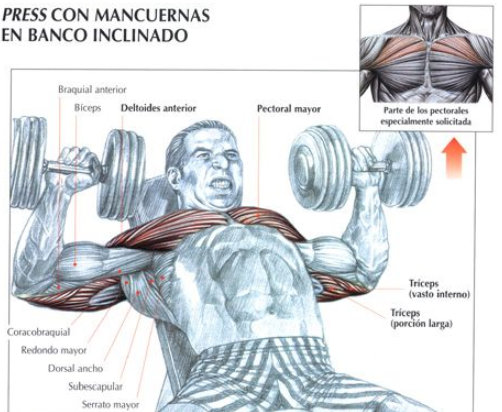
The dumbbell upper chest bench press is the ideal exercise for pumping your upper chest on an incline bench. First of all, you will need a bench where you can adjust the incline (adjustable bench). You can do incline dumbbell presses on a bench with the backrest at 30 or 45 degrees.
More advanced athletes can benefit from the incline dumbbell press , as it is a complementary way to stretch the pectoral fibers with greater travel. As with the barbell upper chest bench press, the anterior delts and triceps also get extra work. When doing dumbbell incline presses you should follow the same principles and recommendations that we mentioned above for the barbell press.
Dumbbells allow you to work unilaterally, so they are excellent for correcting strength imbalances between the left and right sides of the torso. A very common problem when doing a barbell bench press is that we have more strength with one arm than with the other. This can be remedied by doing incline dumbbell presses. In this way, the exercise will not only serve to work the upper chest area , but also to improve coordination, stability and balance strength.
If during the exercise we feel pain or discomfort in the shoulders, we will slightly bring the dumbbells closer to the torso by putting the elbows inwards. Thus, the load on the shoulders will decrease.
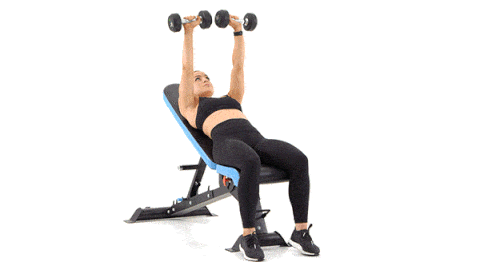
Why Do Incline Bench Dumbbell Presses?
During the dumbbell incline press movement , the athlete performs an upward push. These types of exercises improve explosive strength and increase testosterone. The benefit of the dumbbell upper chest bench press is that this exercise allows you to exercise the thoracic area of the body well, as well as increase strength marks in other exercises . This exercise is perfect for beginners and will be a good base for pumping your chest. Working under the supervision of a coach, a beginning athlete can quickly take the first steps toward good technique. Also the Incline Bench Dumbbell Press is a very effective exercise to start your training day.
For professional or advanced athletes, the Dumbbell Upper Chest Bench Press is the perfect fit . When a bodybuilder is stuck on the upper barbell chest press, he can incorporate the dumbbell version to gain extra strength and transfer it to the core exercise. Also experienced athletes need to regularly change the training program. This exercise will help add variety and diversify the process of pumping the pectoral muscles. You can practice in the gym using the superset method. For example, you can combine the flat bench press exercise with the dumbbell upper chest bench press, or with push-ups performed at different grip widths. You can combine this exercise with other chest exercises without rest.
The incline dumbbell bench press is also perfect for women. Girls should work with a weight that is comfortable for them. Before working out with the iron, they can test the basic strength with the help of the usual push-ups. And, as we are going to see now, there are also other interesting exercise variants for them: the upper chest press with bands , the upper chest press in multipower ...
What are the differences between doing the upper chest bench press with a barbell and with dumbbells?
We have already commented that barbell presses are the basic exercises of bodybuilding and weightlifting. Pushing movements are what provide strength, power and size to the torso. However, to increase the results of barbell exercises (eg, bench press), the athlete should also perform dumbbell lifts. There are several differences regarding the use of both equipment (bar and dumbbells). There are also several advantages to training with dumbbells instead of a barbell, and vice versa.
- Security . Barbell exercise is not as safe if there are no partners to help you. A heavy weight can cause problems for the athlete if it stays under the bar. If you don't have a partner or coach and you're not too confident in your abilities, then use the incline dumbbell press instead . They can be lowered easily, without injury.
- Range of movements . In the incline barbell press the athlete has a limited range of motion. Both hands push the same bar. Therefore, the athlete cannot increase the amplitude of the movement in the series. Many bodybuilders claim that when they work with a barbell, the pectoral muscles do not receive the proper workload. Performing the incline dumbbell press increases joint mobility. Dumbbell movements are considered more natural to the body of bodybuilders.
- The ability to improve the coordination of movements . With dumbbells, the athlete will need to perform movements immediately with two accessories at once, something that can quickly and effectively improve the neuromuscular connection in the human body. Thus, the athlete will improve their ability to coordinate movements. This skill will also help you in daily life.
- Independence . Dumbbells give you the opportunity to work with both hands separately and at the same time. This type of press helps athletes who are recovering from injury. Thanks to localized work, an athlete can recover the strength of an injured muscle; The Incline Dumbbell Chest Press balances core strength. Dumbbells correct a very common problem with the incline barbell press , which is that one arm often exerts almost all of the force. Using dumbbells, the bodybuilder equally engages the right and left parts of the body. Thus, it is possible to quickly eliminate the imbalance of strength in muscle groups, as well as in the aesthetic proportions of the athlete.
- Versatility . With the help of dumbbells, a bodybuilder can pump all muscle groups of the body. It is safe to work with them, and also very comfortable. The athlete has a large number of basic and isolation movements available to work with dumbbells.
- The possibility of using dumbbells in different conditions . Dumbbells are small-sized sports equipment that take up little space. They are very easy to store at home. You can also take them with you during long car trips. In this way, you can always effectively maintain the good state of your fitness.
DISADVANTAGES OF THE DUMBBELL INCLINE OR UPPER CHEST BENCH PRESS
In addition to the positive factors, there are a number of drawbacks to doing dumbbell incline bench presses. The most basic drawback comes when it comes to increasing weights. To deal with this effectively, you must have a large number of dumbbells. But the problem can be solved by paying a gym subscription or buying some adjustable dumbbells. If you're training at home, even a rocking chair with a sloping back can help you improvise this exercise.
One big advantage of the barbell over dumbbells is that you'll usually be able to lift more weight with the barbell.
Upper Chest Bench Press at Home and Other Ways to Perform Upper Chest Press
The curiosities and surprises for this exercise do not end with what we have explained to you. Stick around a bit longer and learn some interesting variations on the incline press. Some of the ideas that you are going to see will be really useful even for doing the upper chest bench press at home .
Can I do the upper bench press without a bench?
Yes. An effective alternative if you don't have the bank or it involves an economic investment that you can't afford is to use a rocking chair or a Swiss ball . For both cases, the ideal is to perform the version of the exercise with dumbbells . The movement of the press is as we have explained in this guide.
 |
| Use a rocking chair to do an upper chest press without a bench at home. You will only need the dumbbells. |
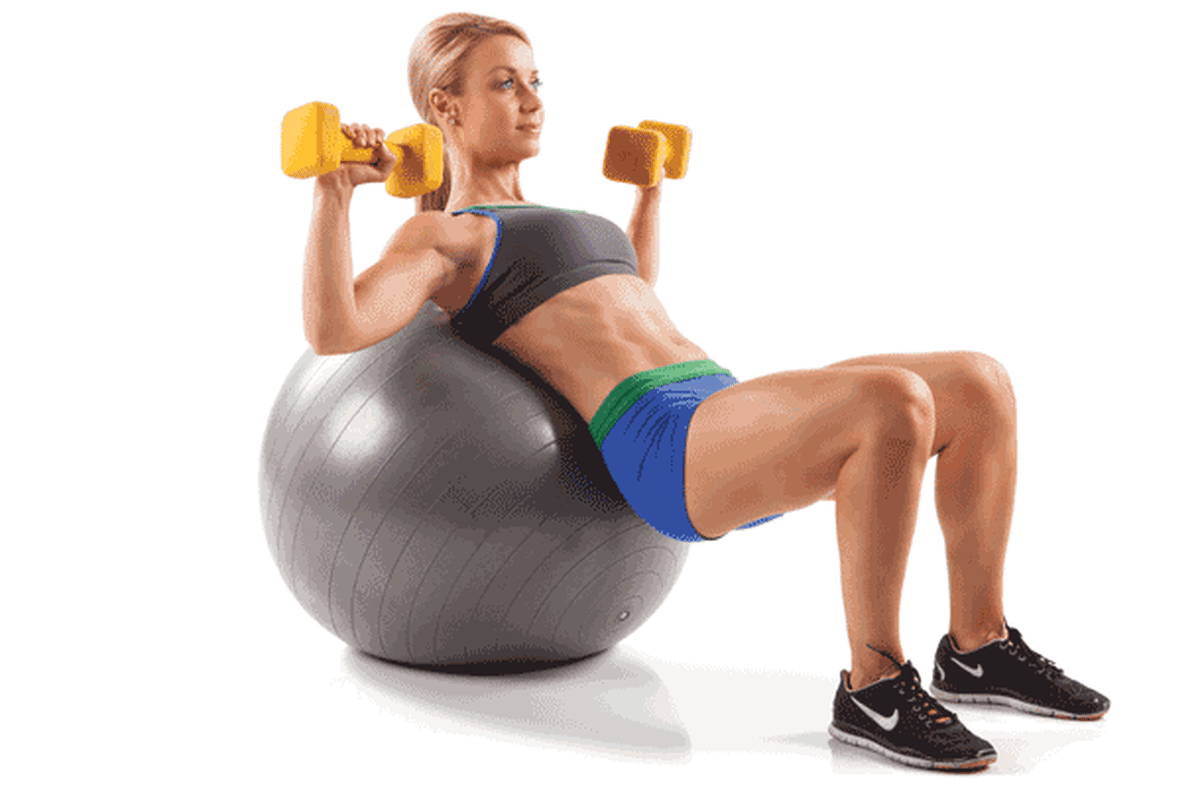 |
| Watch the animations to see how to do the Incline Swiss Ball Press . |
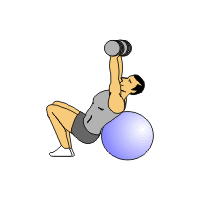 |
| This upper chest press is without a bench and, in addition, with the Swiss ball you will train the stabilizer muscles . The ball is a surface on which it is difficult to maintain balance. Obviously, you will have to take lighter weight dumbbells. |
Upper chest press with bands, another highly recommended variant
Gymnastic bands are another effective way to upper chest press at home and, more interestingly, upper chest press off the bench . Simply anchor the rubber bands to the door and make a push movement, extending your arms diagonally forward, as shown in the animation:
|
| You can perform upper chest press with elastic bands at home and without a bench . Rubber bands have the advantage of taking up little space and you can take them wherever you want. You can try different weight rubbers to increase the intensity. |
If you want, you can also use a bench to do upper chest bench pressing with elastic bands .
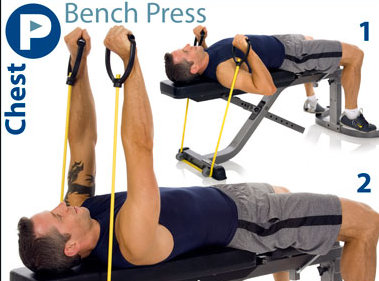 |
| Execution of a bench press with bands on the bench. |
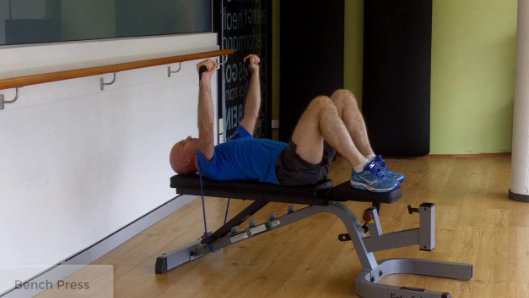 |
| A bodybuilding practitioner performing the bench press with elastic bands. |
You can even buy weight benches that already have built-in elastic bands. They are ideal for upper chest pressing at home. Look at some options.
Upper chest press or inclined bench press on the multipower or Smith machine
This is another variation that you can often do in commercial gyms that have the machine. It is not a basic exercise, but it will help you to give more variety to the routine and pump your chest. Keep in mind that you may not be able to load as much weight doing the multipower incline bench press . Adjust the bench to the correct incline or degrees and try this exercise. Like all, it has some advantages and disadvantages .
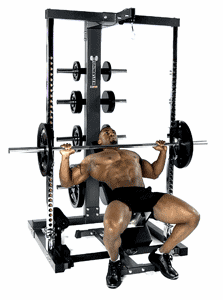 |
| Execution of the multipower incline bench press . |
ADVANTAGES OF THE INCLINE BENCH PRESS IN MULTIPOWER
- Greater isolation of the pectoral muscle.
- Possibility of training alone and without supervision. There is no danger of going under the bar on a miss.
- Excellent complement to pump the pectoral or finish a pectoral routine.
DISADVANTAGES OF THE INCLINE BENCH PRESS IN MULTIPOWER
- It is more damaging and can generate greater stress on the shoulders. You have to be careful.
*We recommend taking a short chest pause if doing the multipower incline bench press.
- The movement, since the bar is guided, is less natural than that of the free incline bench press. There is increased stress on the joints .
- This exercise allows us to load less weight than we usually use.
- Some people find it uncomfortable to work on a multipower machine.
Incline Down or Decline Bench Press
The so-called downward incline bench press is not an upper chest press. Although we're going to take a look at this exercise (actually called the decline press), it's the complete opposite movement of the upper chest incline press.
Just as the incline (up) trains the upper pecs, the decline (putting the bench down) trains the core and lower pecs. Unlike the incline, which puts pressure on your shoulder joints and deltoids, the decline bench focuses primarily on your chest.
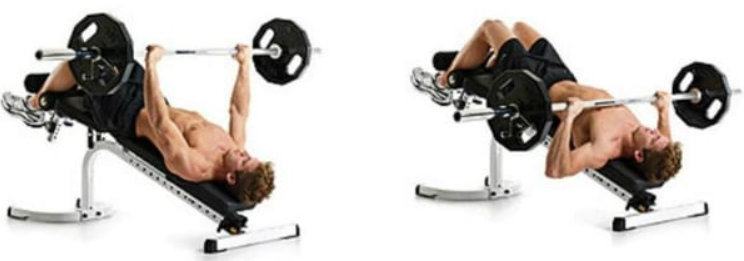
You should never, ever use a "false grip" (not wrapping your thumb around the bar) when doing this exercise. If the bar slips out of your hands it could fall on your neck.
FINDING THE BEST ANGLE FOR THE INCLINE PRESS DOWN OR DECLINE PRESS
Popular with bodybuilders like Ronnie Coleman , the incline press down is best done on a true decline bench . The one where you often see people doing sit-ups. As such, the angle is generally what the established bench already brings.
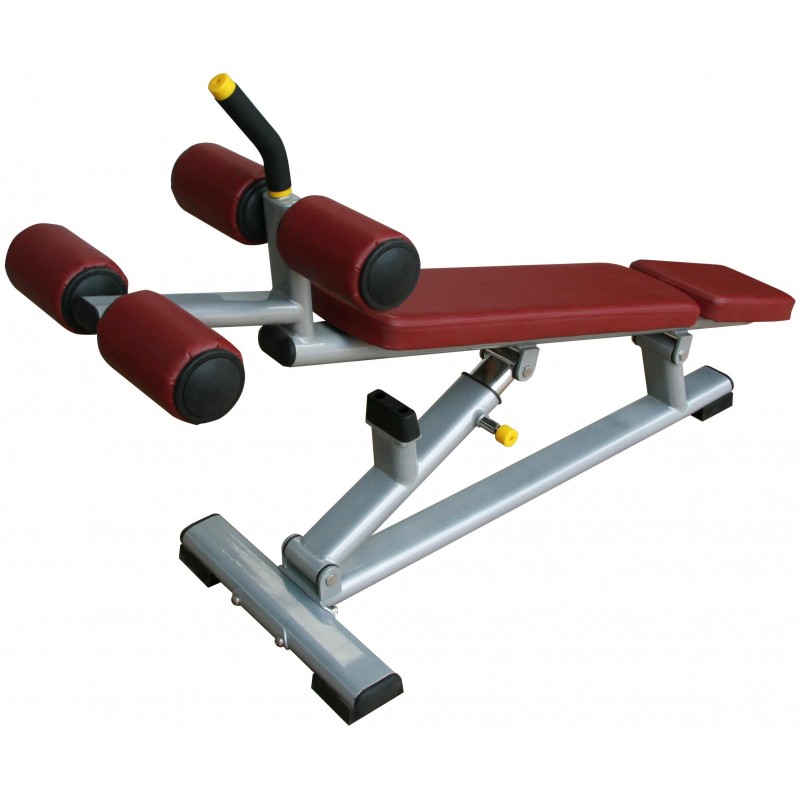
You just have to sit on it, hook your legs under the end of the bench and lie down. If you're too far from the bar support to pull it out yourself, ask someone to give it to you. With some practice, you'll also be able to pull the bar yourself . Use a mid-width grip so that you form a 90-degree angle between your forearms and biceps when you're mid-motion.
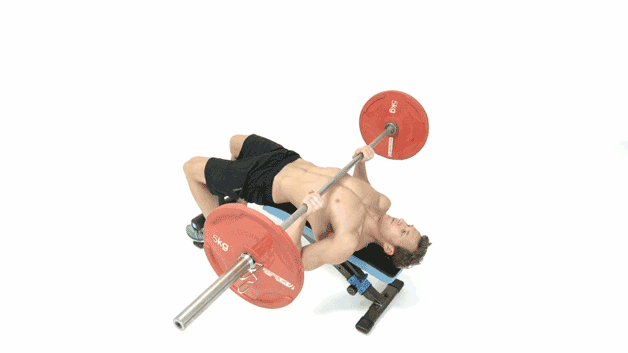
If the bench you use is adjustable , you will have to experiment with the declination that feels right for you. If you put a lot of pressure on your shoulders, try adjusting it until it feels comfortable.
USING DECLENSIONS IN YOUR TRAINING
The incline downward press exercise can also be done with a barbell or dumbbells . If you don't have a helper, dumbbells are the safest option and also offer a greater range of motion .
Just like we recommend for the incline bench press, you can do the decline exercise with both dumbbells and barbells to maximize pectoral growth .
Chest workout from all angles
You can combine the different angles and exercises together to fully work your chest and build a striking torso. To finish, we are going to give you this little basic routine that will be very helpful. Put it into practice!
Routine example:
3 x 8-12 reps barbell flat bench press
3 x 10 reps barbell incline bench press
3 x 10 reps dumbbell decline bench press
3 x 8 reps dumbbell incline bench press (uses heavy dumbbells and varies the tilt angles: 15, 30 and 45 degrees)
Thank you very much for reading, dear reader. We hope that all the information contained in the incline bench press guide has been very useful to you. If you have any suggestions for us to improve, you are welcome to contact and tell us!
Read other interesting articles!


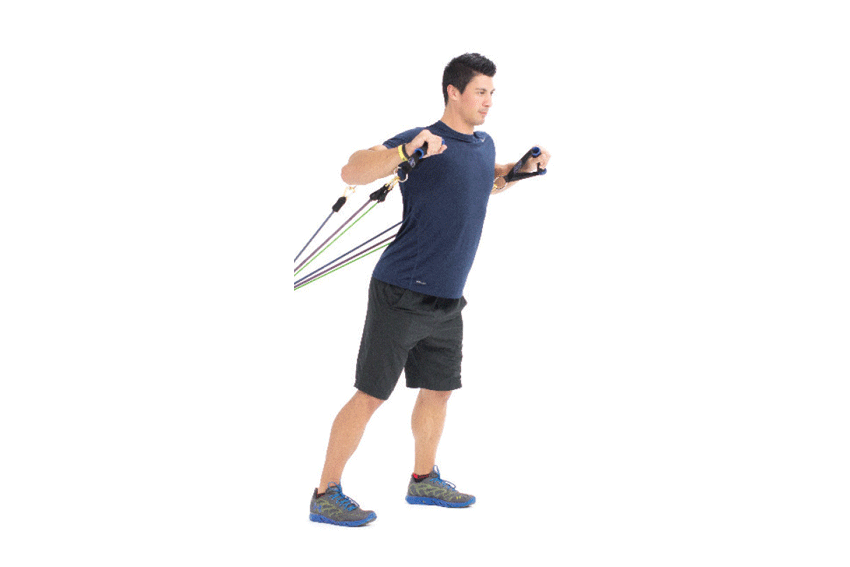



![LAS MEJORES MÁQUINAS DE MUSCULACIÓN PARA PRINCIPIANTES [GUÍA 2025]](/modules//smartblog/images/no-home-small.jpg)
![HOW TO BUILD A HOME GYM ON A BUDGET [2024 GUIDE]](/modules//smartblog/images/296-home-small.jpg)


